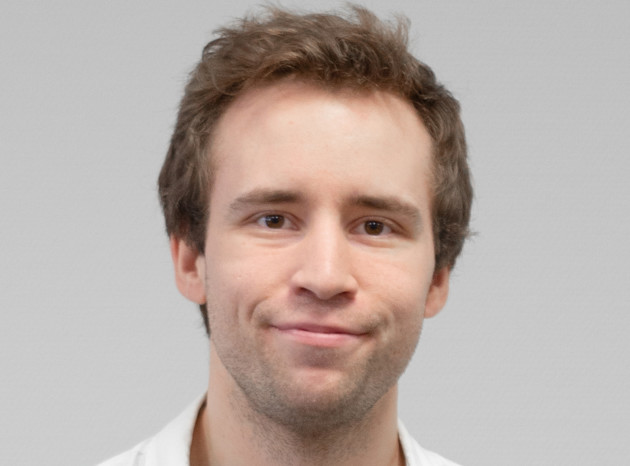Simon's grad project landed him his dream job
In his master’s thesis, Simon Linge developed an idea for a robot that buzzes around hospital halls stacking shelves. The goal? Allowing nurses to spend more time with their patients. The grad project was done in collaboration with ABB, where Simon now works at one of the company's research departments.

“We are researching how to develop new systems and products based on user needs” he says. “What we are working on is not products and services that will be released on the market tomorrow, we are looking to the future and always have a long-term perspective.”
ABB is a large, international company that manufactures robots, process management systems, engines and control systems, among other things. Simon cannot not say exactly what kind of products, systems and services he's working on at the moment, as these are company secrets.
What's the best thing about your job?
“That I get to try to figure out how to make the world better by helping people through using technology solutions. And that I get to do it in a very nice team in a company that works with very interesting technologies and big issues.”
Robot project in hospital environment
What led Simon to the job, right after graduation, was his final school project. For his thesis on the master's programme in advanced product design, Simon developed a concept for a hospital robot. The project was done in collaboration with ABB, University Hospital of Umeå and Karolinska University Hospital.
“I had the opportunity to go into the hospital environment and shadow nurses in seven different departments and interview them about their work, to learn what problems they face in their everyday lives. The approach is based on a methodology tha aims to understand the user's needs, the problems that people encounter, and then trying to design products and services that actually help them.”
Health care staff were invited to workshops at Umeå Institute of Design. Together with them, Simon decided to design a solution towards one of the basic routine tasks today carried out by assistant nurses. That is to refill hand sanitizer, aprons and other hygiene items that, according to the requirements of the National Board of Health, must be found in all patients’ rooms.

Simon Linge's hospital robot Pluto at work.
ImageSimon Linge“These are tasks that today mainly fall on the assitant nurses. Wonderful people with lots of empathy and medical skills who are passionate about helping people. But, a lot of their skills do not come into use because they have to spend a lot of time doing menial, repetivtive tasks. I identified a scenario where a robot can come in and relieve the most basic tasks so that the nurses can get more involved with their patients. Empathy is an important skill. A robot cannot express empathy, but it can support health care staff in many other moments that actually distract us from engaging with each other.”
Simon's design is a concept, not a fully functioning robot. He believes it will probably be a long time before such health care robots are scurrying around hospital corridors carrying out practical chores such as refilling medication, mopping floors and helping with heavy lifting. But, he himself believes in a future where robots are performing such routine tasks. He's more skeptical about the possibility of social robots, for example as companions to the elderly. Why should robots do what humans do better, he says.
Methodology for developing products
How do you think your studies have prepared you for your job at ABB?
“The studies have prepared me really very well. There are two things I mainly brought with me, professional skill in industrial design and the methodology for developing products with a clear user focus.”
Did you join the bachelor's programme in industrial design at UID as well?
“No, I took my bachelor at the industrial design programme at the Lund University of Technology. First, I started to major in civil engineering, but dropped out after a few weeks and chose industrial design instead. It was a very broad education, focusing on materials, mechanics and broaer engineering skills but also a lot of artistic focus. Among other things, life drawing, painting and semiotics (the teaching of signs and symbols).
Did you come directly from high school?
“No, I had done some other things before, including working for a year at the production line at Volvo in Olofström. Ironically, I worked alongside ABB robots meaning that I have, sort of, come full circle now that I work with research on robotics at ABB.”
How will you remember your study time in Umeå?
“It was intense, and so much fun! I learned so much, met lovely people and developed a lot, both as a designer and a person. I also now notice the difference in how I think compared to when I started at UID. The education in Umeå is very close to reality and the industry. You work in collaboration with companies, meet their designers and managers, go out and do user studies while working on actual real-life projects. For example, we worked with Atlas Copco developing hydraulic tools, collaborated with the police department on an infrared 3D scanner, with Umeå Energi on an energy storage project and with the University Hospital of Umeå on a hygienic water tap. We really got to work with real things that matter in peoples' lives”
About Simon Linge
Age: 29 years.
From: the depths of Småland.
Lives in: Västerås.
Education: Master's programme in advanced product design, Umeå Institute of Design, Umeå University, Sweden, graduated in 2019.
Job: Industrial Designer and User Experience Researcher at ABB Corporate Research in Västerås.
Hobbies: Climbing and biking among other things.
Myself in 3 words: Thinking. Curious. Stubborn enough.
Umeå in 3 words: Welcoming. Beautiful. Powered.
What I'll do in 10 years: Will still be developing exciting products.
